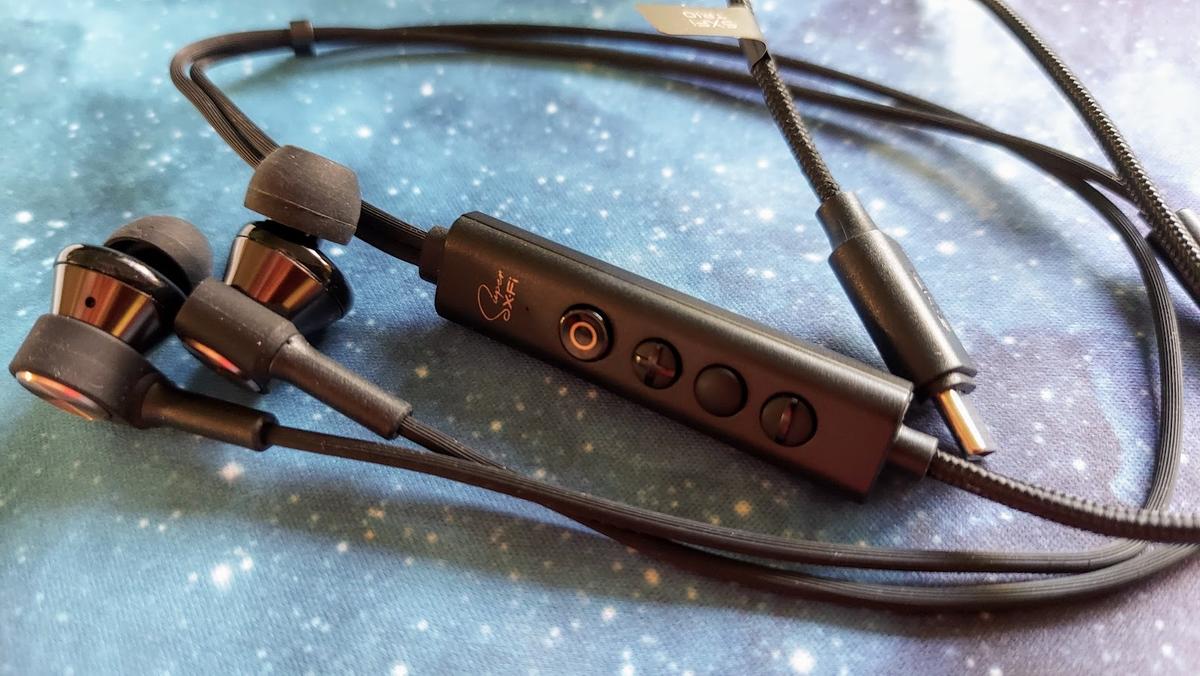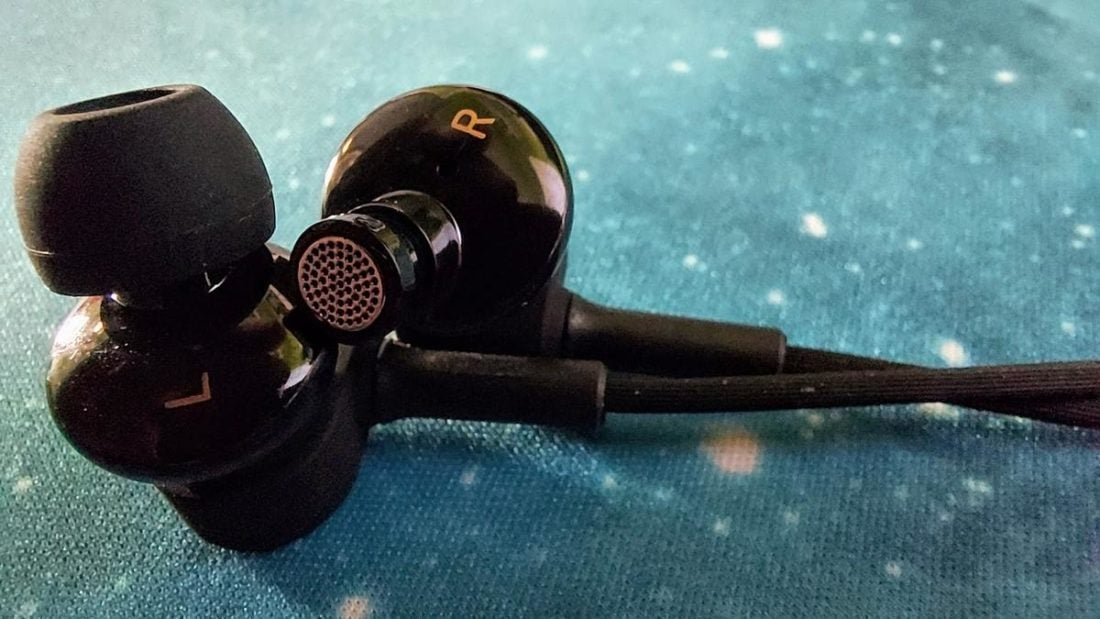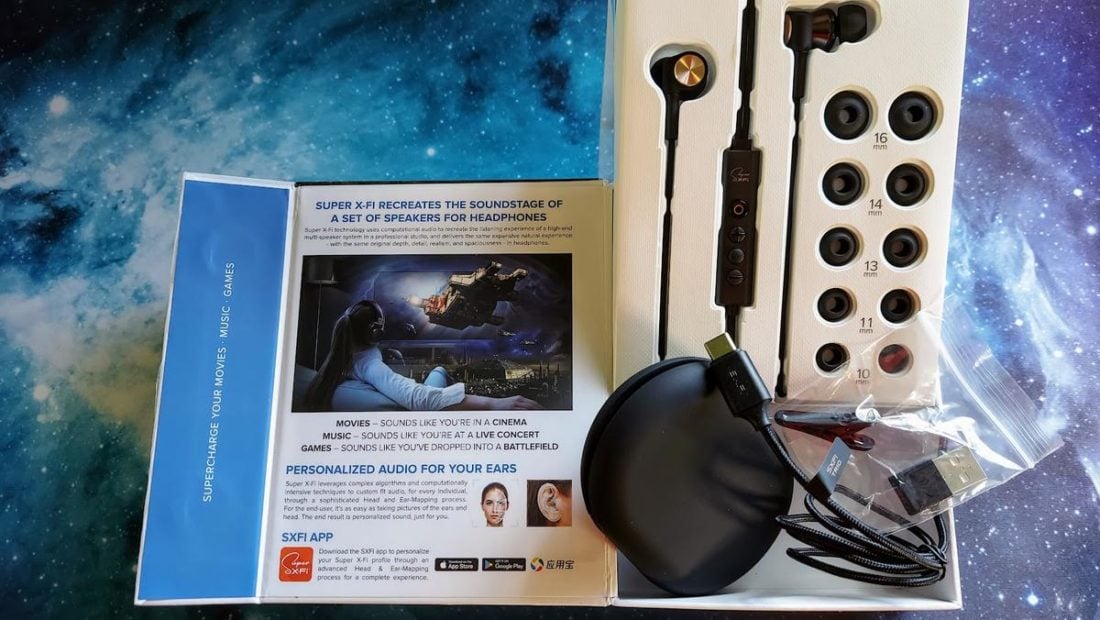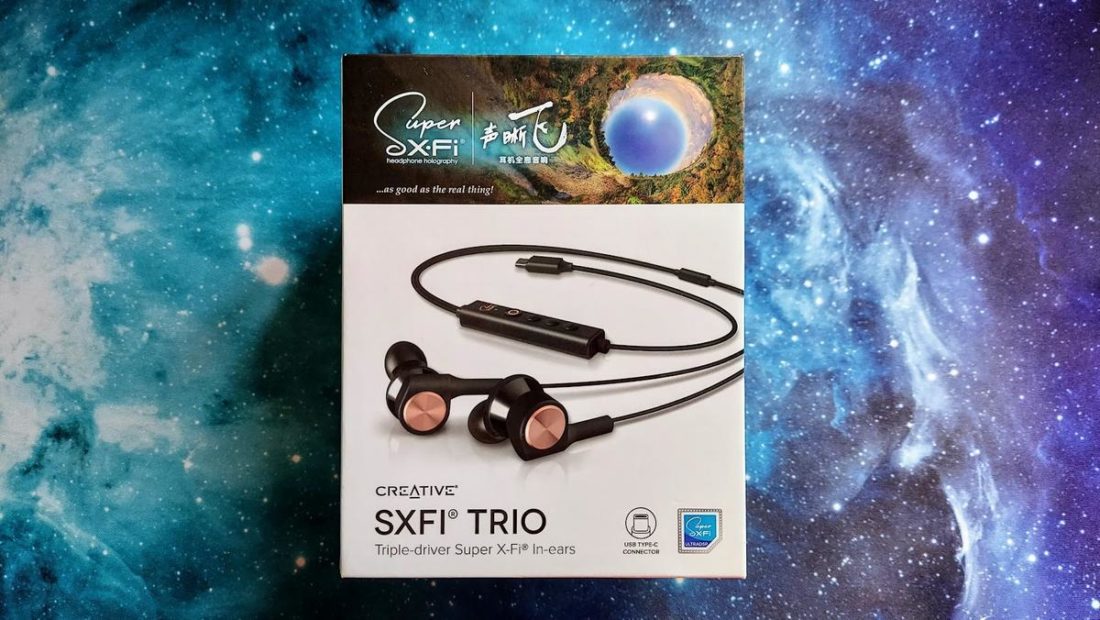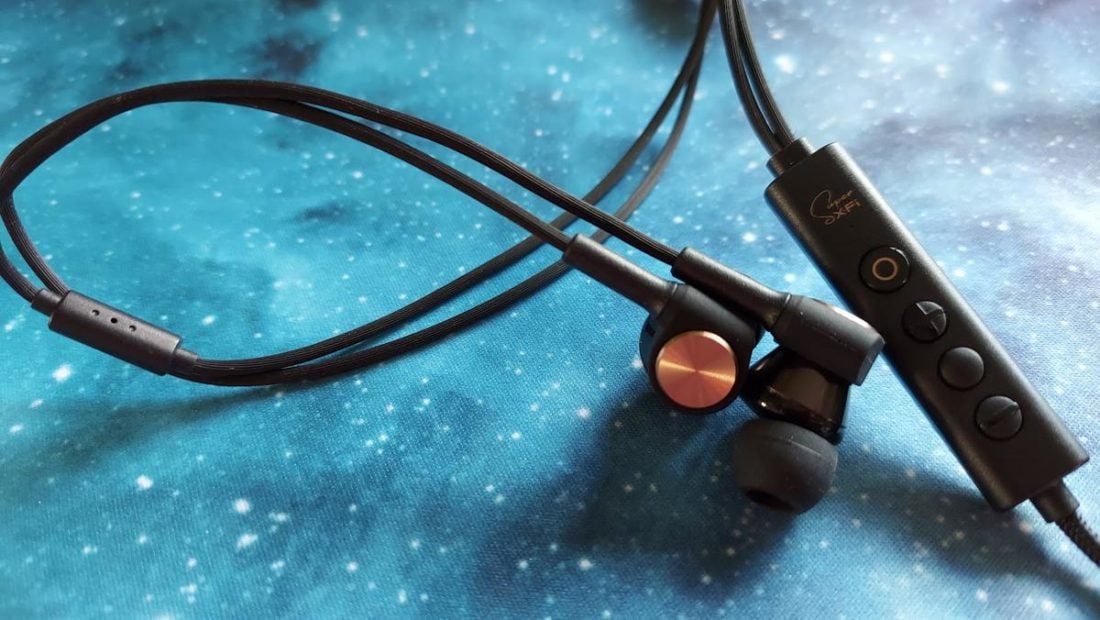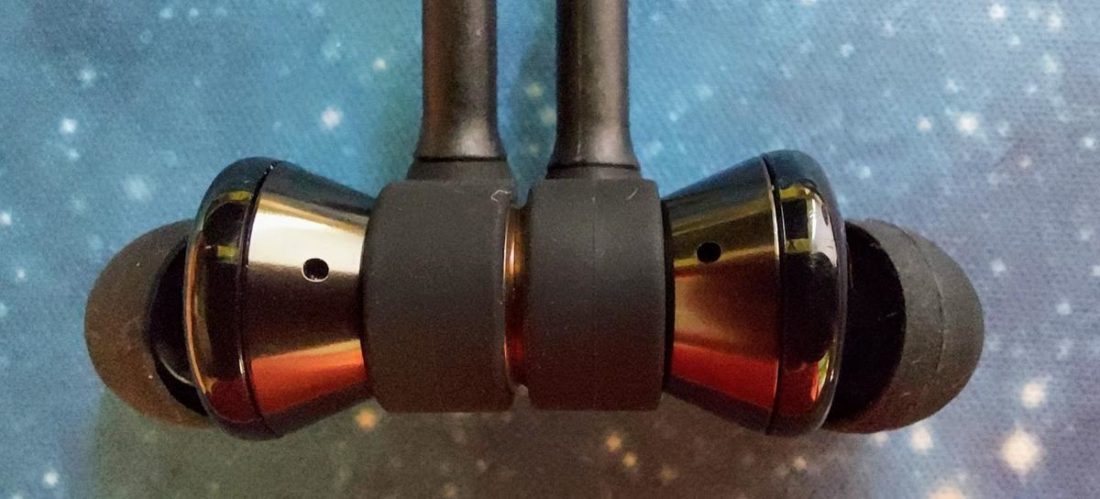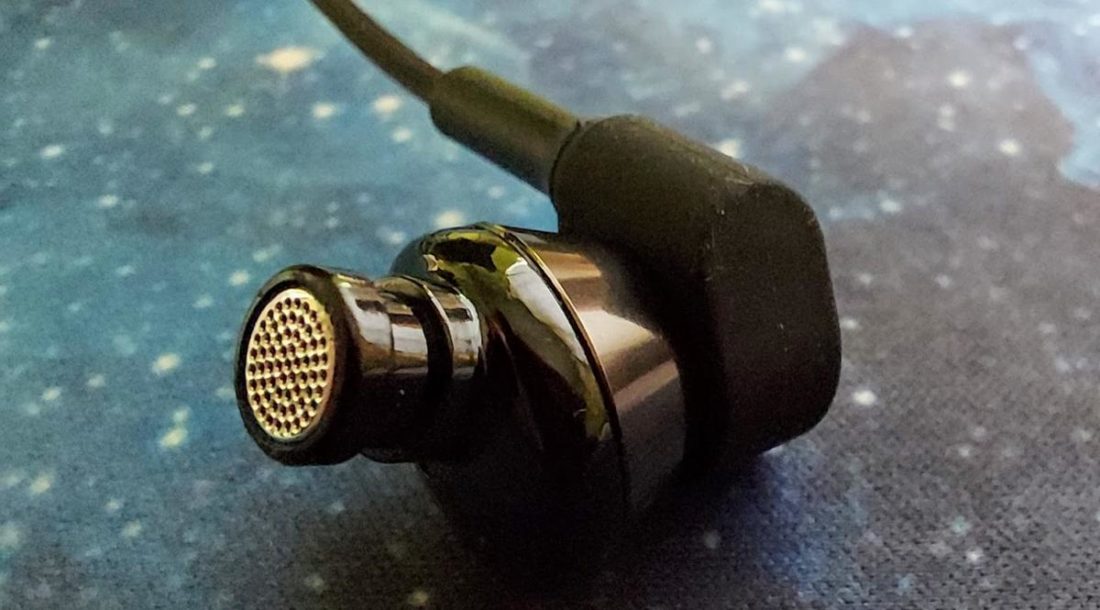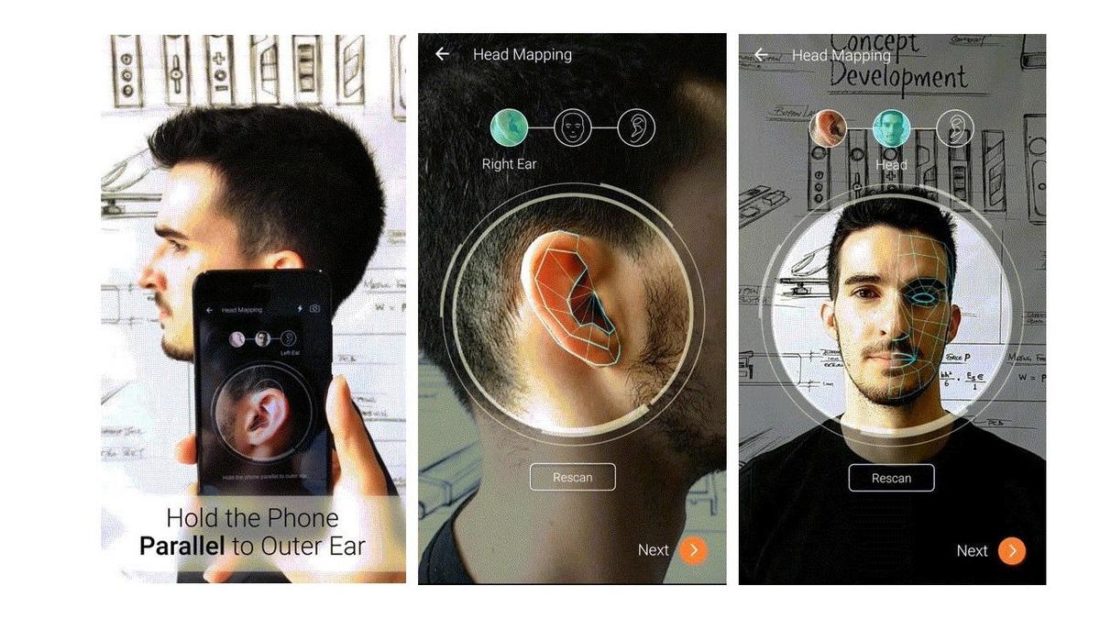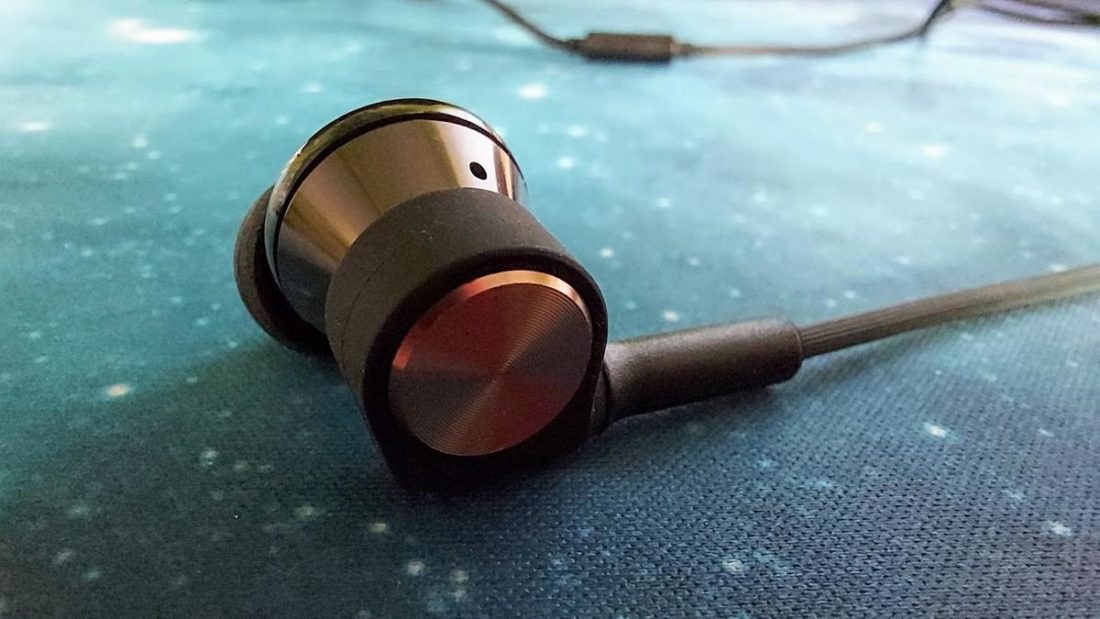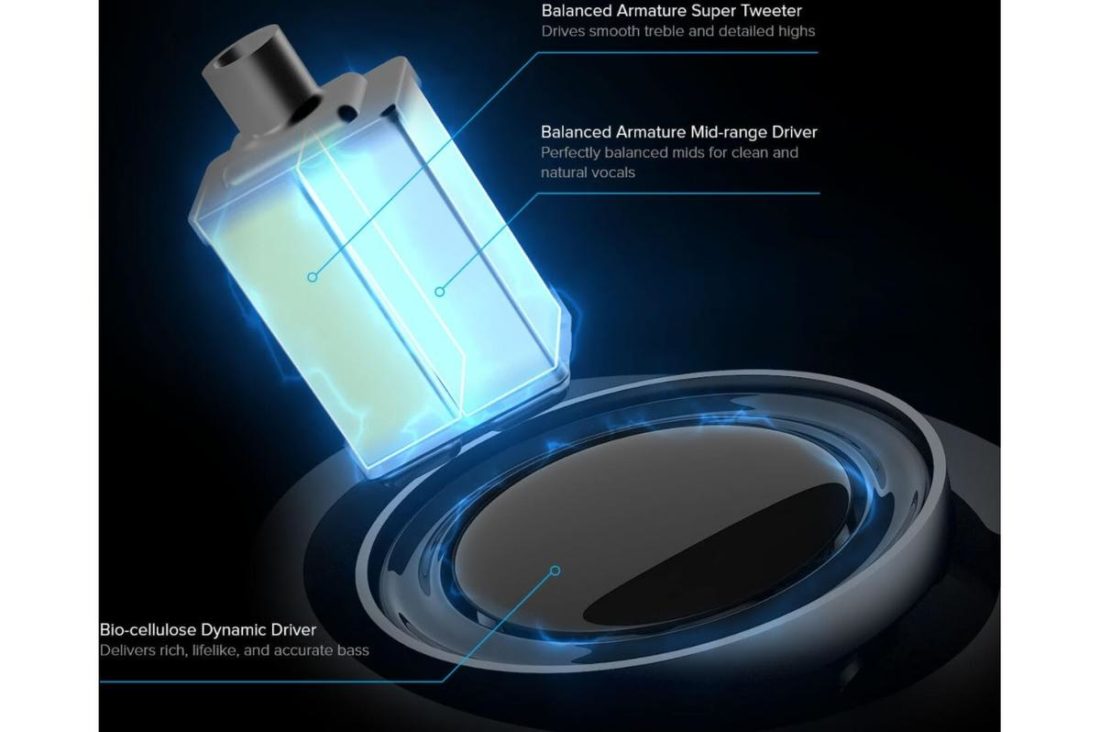It’s not quite appropriate to label these simply as headphones, earphones, stereophones, or in-ear monitors (IEMs). Released in 2020, the Creative SXFI TRIO are an innovative and affordable all-in-one, high-tech, personal sound system. Specifically, the TRIO combines a DAC, amplifier, and earphones into one integrated product. These are specifically designed for audio, video, and gaming enthusiasts, and there is nothing quite like them on the market. The question is: will the SXFI TRIO’s ‘not really for everyone’ approach be for you? Creative calls them in-ear headphones. For our purposes, I will call them earphones, as they insert into humans’ ear canals, have non-removable cable connections, and will likely never be used for studio monitoring or stage performances (like IEMs). Creative is nothing if not creative in their engineering, technology, and marketing. Creative has lived up to its name, producing category-defining and leading technology since 1981. The design and build? That has varied a bit more over the years. Presumably, there is a great deal of advanced science, technology, research, and development that has been invested into SX-Fi and this family of audio devices. This review is intended to be more experiential rather than a deep-dive technical verification of scientific validity. Will the SXFI TRIO live up to both their namesake and the grandiose, over-the-top magical marketing claims?
First Impressions
The busy box is captivating despite all its over-the-top graphics and hype. The TRIO are an all-in-one product with components that are small, yet substantial. Immediately, I feel that these are very well made and are built to last. I am impressed by the large and incrementally sized collection of silicone ear tips. I’m also uncharacteristically hopeful that I will find a great fit. The flexible carry pouch brings back memories of rubber oval coin purses from decades gone by. I will declare that I am a long-time Creative personal consumer, general follower, and historical fan. My favorite pre-smartphones digital audio players (DAPs) were Creative innovations, all of which are now sadly extinct and long gone. I own many Creative products, from computer sound cards and speakers, earphones and headphones, to portable Bluetooth speakers. Most are excellent, with rare misses and disappointments. My first experience with SXFI was when the technology was embedded into some of Creative’s Zen series DAPs, such as the Creative Zen X-Fi. Since that time, SXFI technology has evolved. It’s been a long time since I’ve listened to an SXFI-enabled product, and I’m anticipating that I will hear the progress they’ve made.
Company Overview
Creative Technology Ltd, founded in Singapore in 1981 and publicly listed on the Singapore Exchange (SGX) since June 1994, is a worldwide leader in digital entertainment products. Creative envisioned that multimedia would revolutionize the way people interact with their PCs. Famous for its Sound Blaster sound cards and for launching the multimedia revolution, Creative is now well recognized as a global leader for product innovation in the audio and Personal Digital Entertainment (PDE) segments, offering consumers a complete, high-quality digital entertainment experience through Creative’s hardware, software applications, and services.
Who Are They For (And Not For)?
The SXFI TRIO are designed to work with fully compliant USB-C Android phones and devices. If Apple is the ecosystem you call home, these are not for you. The SXFI TRIO are not compatible with iPhones or older USB Micro-B phones. In addition, some phones display only partial compatibility with the SXFI TRIO and may have limited mic functionality. For example, most Samsung phones implemented their USB-C differently from the Android standard, and thus exhibit microphone compatibility issues. The music playback function is not affected. These may be your ideal earphones if you can enthusiastically complete the following sentences. I …
love music and movies. love gaming. love bass and powerful, immersive audio. spend lots of time on phone calls, video calls, and virtual meetings. have USB-C devices that I will use with the TRIO.
The TRIO are a clear win for enthusiasts who want something far from the usual and perform at an entirely different, and overall, higher level than basic, mass-market earphones. In addition to their music quality performance, the TRIO are a gamer and movie lovers’ dream come true. They are unique and unrivaled in the market (the closest approximation is Creative’s own over-ear gaming headsets and full-sized headphones, or external devices such as the Sound Blaster Omni Surround 5.1).
Technical Specifications
Drivers: 10 mm bio-cellulose dynamic driver with dual balanced armature drivers (one super tweeter and one midrange driver) per earphone Impedance: 32 Ohms Sensitivity: 109 db/mW Frequency Range: 8Hz – 30KHz IMD: < 0.008% (reference: IMD vs. THD+N) Crosstalk: < -90 dB Signal-to-Noise Ratio (SNR): up to 100dB Supported Input Format: Stereo/5.1/7.1, 24bit/96KHz Chipset: X-Fi Ultra DSP chipset Noise Isolation: Passive Built-in Microphone: MEMS microphone, frequency response: 100Hz – 10KHz Style: In-ear Connector: USB-C (low-jitter asynchronous USB UAC2) Software: SXFI App (Android/iOS/Windows Store/Mac Store) System Requirements: Windows 10 Creator’s Update (ver. 1703) and later; Mac OS 10.13 (High Sierra) and later; smart mobile devices running Android 7 and later; PlayStation 4 / 4 Pro & Nintendo Switch Weight: 29 grams (complete) Cable Length and Type: 1.2m (3.9 ft) OFC audiophile grade (kevlar); 35cm (ear buds length), 5cm (In-line control), 80cm (USB Type C cable)
Packaging
Packaging is sharp, efficient, and nifty, with an unfolding magnetic locking cover. Every single surface has something on it, with virtually all the information a buyer would need to make a buying decision. Opening the cover, the earphones, cable SXFI controls, and ear tips are cleanly displayed in a white cardboard display and storage tray under a stiff, clear plastic cover. Hiding under the tray are the extra printed materials and carrying pouch.
In the box
Creative SXFI TRIO earphones 6 pairs of silicone ear tips (varying sizes) Carry/travel pouch Secure clip (for cable) Printed Quick Start Guide and Warranty leaflets
Cable
The original Creative SXFI AMP was transformed into the SXFI WIRE and integrated within the SXFI TRIO. The SXFI WIRE is 40% smaller than the SXFI AMP and performs equally as well with the same Super X-Fi UltraDSP Chip built-in. Creative touts its cable as “OFC Audiophile Grade.” The TRIO are specially engineered with Kevlar-reinforced copper for exceptional tensile strength and wrapped in an aluminum and copper shield that makes it highly durable. The cable is then finished with a nylon braid to achieve maximum flexibility and is capable of high-speed data transfer to drive the maximum potential of the TRIO. Oh, the cable…. It’s as frustrating as it is strong and durable. The cable is substantial, feels virtually unbreakable, and does not tangle. While I’m not sure how much weight it will bear, I am sure that the amount and volume of microphonics transmitted, especially through the upper part of the cable, is unacceptable. There are two different parts to the cable, one being the lower fabric-covered cable with the USB-C termination (that part is likely the Kevlar weave). This connects to the inline control center with multiple buttons (volume, multifunction, and SXFI). Moving up, the cable exits the control, splitting into two rubberized cables, each heading to the earphones. If we were still living in the 1980s, I would be more tolerant of the microphonics (that was normal at the time) and revel at the build quality. The cable would appear as futuristic as the SXFI sound. It comes with an inline digital audio amplifier and processor, volume and multifunction controls, a separate well-placed high-sensitivity MEMS (micro-electromechanical systems) microphone, an adjustable slider, and even a shirt clip. The shirt clip is the only attempted saving grace or you must remain very, very unnaturally still. The slightest of movements is detectable through the earphones, especially when there is no signal or the media volume is low. In 2021, sub-$30 IEMs often come with beautiful, flexible cables that transmit virtually no noise or interference. With the power of Creative’s research, development, and engineering, or at least their sourcing departments, this ought to have been a non-issue. I’m at a loss as to how the TRIO achieved final product design approvals and user experience testing. At this price point, and with all the exemplary marketing hype and self-congratulations, it seems reasonable to expect an excellent cable in form and function. Adding to my frustration, the cable is permanently affixed to the earphones and non-replaceable, unlike those inexpensive IEMs aforementioned. If this were possible, designing around the SXFI control module, I would not be as bothered.
Design
The black and gold of the TRIO are completely understated in contrast to the packaging and language used to describe them. They are tidy, compact, clean, and flawlessly machined. Each earphone housing is assembled in multiple pieces, though fit seamlessly. The nozzle has an excellent collar that secures the ear tip well. The bronze-colored bodies are smooth and quite luxurious looking, with a port hole likely drilled for internal pressure release. The round, gold-colored faceplates have a fine-grained circular pattern etched into them and are fitted with strong magnets that hold the earphones together when back to back.
Comfort
The TRIO are very comfortable to wear for long periods of time – only if you can relieve the pressure on your ears from the strain of the cable and SXFI inline amplifier’s weight. Mind you, the TRIO are an engineering feat at a lightweight 29g. If you are used to true wireless earbuds (TWS), wearing something with a wire that does not wrap around the ear will be noticeable. The weight becomes a non-issue as you learn to best utilize the included clip, optimally placed approximately 3-4” above the SXFI WIRE inline amplifier. The body to nozzle angle feels exactly right and results in no uncomfortable contact to the ear while still achieving excellent sound isolation using the provided Creative AuraSeal noise isolation ear tips. This is so much the case that I have to be careful and slow removing them from my ears to avoid a (highly unpleasant) vacuum suction-like release. It is relatively easy to achieve a secure, proper, and tight ear tip seal given the extensive small-increment size options. When the cable is secured well and I’m not moving much, the TRIO are all day comfortable.
Internals
The TRIO use an in-house tuned, hybrid triple-driver system consisting of a 10mm bio-cellulose dynamic driver and two balanced armature drivers per earphone (configured as one super tweeter and one midrange driver). Buttons switch Super X-Fi audio holography on and off, increase or decrease the volume, and control music playback.
Performance
The TRIO are a plug-and-play device. Expect that it will work as an audio output on most (but not all) USB-C devices, including smartphones, tablets, Chromebooks, computers, DAPs, etc… Given the USB-C connection, and a need to be powered by your portable device, know that this may be a significant battery power drain, especially if you have the volume maximized on the inline TRIO amplifier. On phones, you will not have the ability to charge the phone if you only have a single USB-C port. On many current computers and Chromebooks, this will be a non-issue. After you download the Creative SXFI app on your smartphone and create an account, you will be asked to choose your supported product (TRIO) and then go through an elaborate personalization process. The app uses head mapping technology (photos of your head) to customize the TRIOs audio just for you. Pro tip: get another human’s help with getting proper scans of your ears. Once you have completed this procedure, the app uploads your personal profile to the TRIO! More specifically, your profile is saved in the SXFI module in the cable itself. As a result, this profile will always be there regardless of the source device you use, no app is required. I cannot verify whether or not these images and algorithms significantly alter and/or improve your sound, as compared to the profile of another user with a very different head. Though I am a scientist, I do not have the proper measurement equipment to confirm. We will have to take Creative’s word for it. The app itself has extensive capabilities as a media player. Embedded is an excellent 10-band equalizer with presets for Flat, Cinema, Classical, Pop, and Game. In addition, there is a custom EQ allowing you to adjust to your heart’s (and ears’) desire. Beware that there is no ability to save multiple custom maps and that the EQ will only work with earphones/headphones connected via USB-C.
Microphone
The SXFI TRIO have been designed to work with fully compliant USB-C Android phones, for example, the Google Pixel series. However, as previously noted, some phones display partial compatibility with the SXFI TRIO and may have limited microphone functionality.
Most Samsung phones implemented their USB-C differently from the Android standard, and thus exhibit microphone compatibility issues. The music playback function is not affected. The SXFI TRIO are not compatible with iPhones and older USB Micro-B phones.
If you spend a lot of time on audio or video calls, or in virtual meetings, the TRIO has the potential to transform your experience and your work. For example, in Microsoft Teams, as well as Zoom, Google Meet, WebEx, etc., there are gallery views of many varieties. WIthout SXFI enabled, the voices are clear, intimately placed in the center of your head directly between your ears. Enable SXFI and your experience of others’ voices radically changes in sound and space – it is a combination of perceived distance and positioning so far beyond the earphones, and it can provide a convincing simulation of being in a real room with real people. In my experience, shifting between modes helps lessen video meeting fatigue, improves attention and focus, and enriches my overall experience. If a person is delivering a monologue, I may turn SXFI off to better tune into the single voice. In multi-person meetings, I turn SXFI on to take all the voices out of my head, so to speak. If I can still make out everyone’s voice clearly, this is far less exhausting. The TRIO have reset my high bar for business/professional duty and are my go-to daily headset replacement. Plus, they are far less noticeable and distracting to others than a larger headset that makes us look like a stereotypical phone operator and messes up one’s hair (if you’re bald, then you can avoid a bright red band across the top of your head from the pressure).
Creative TRIO Sound
For evaluation, I listen to a great variety of music through numerous sources, including:
Sony DVP-S7000 CD Player LG V20 & LG V40 phones with quad DAC (both have headphone jacks) Samsung A71 (in 2020-21, still has a headphone jack!) Samsung Chromebook FiiO A3 Khadas Tone2 Pro
The TRIO are not target marketed to audiophiles. That said, they most certainly could be, and be credibly competitive. More likely, if the TRIO get broader recognition, they will develop a major following of enthusiasts if the audio crowd can see these as more than a novelty for gaming and movies.
Without SXFI
Let’s begin with SXFI off and focus on music. In summary, sound quality is exceptional across all frequencies, especially at this price range. The TRIO’s triple drivers are masterfully well integrated, I cannot determine any step changes, drops, or competing overruns in pass filter frequency separation nor do I hear any evidence of ‘bleeding’ from lows to mids to highs. The engineers and tuners did an outstanding job with the TRIO, producing a product with a fantastic sense of realism and accuracy regarding timbre at all frequencies. This is true across all genres of music that I am listening to. High noise isolation is achieved through a tight ear tip seal. This is easy for most users to achieve with the small incremental steps in ear tip choices and excellent silicone material construction and shape. The nozzle angle is perfectly placed. The TRIO insert into the ear canals at moderate depth and result in no pressure on the ear itself from the body. Imaging is excellent, as is channel independence, instrument/sound separation, and granular detail. Soundstage is somewhat narrow, sounding highly intimate and truly ‘in my head.’ This may be somewhat attributable to the isolation that the TRIO provides. Some listeners love the perception of a huge soundstage, which is where SXFI will come in later. I am enamored with being enveloped by the sound, and at the same time experiencing accurate and dispersed imaging. I find that throughout the frequency spectrum, transitions sound seamless, simultaneously well-integrated, and distinct. The TRIO generally tends toward a rich, warmer, yet well-balanced sound profile. They are highly adaptable to most sources of music and sound. I did not notice distortion at any volume.
Bass
The 10mm bio-cellulose dynamic driver’s bass reproduction is quite amazing. Before we hastily (and mistakenly) judge that as “not that large,” it’s important to remember the resonance created and channeled by the metal body cavity and the sound tube is more important than the physical circumference of the driver. I expected heavy bass given all the focus on powerful audio for movies and games. I did not expect bass with class and character – yet, boom, there it is! The TRIO deliver depth, texture, and authoritative presence. Bass lovers will indeed love the TRIO. Not only do they have sub-bass rumble and mid-bass impact, the TRIO’s direct drivers also produce a grain that feels and sounds natural. Even at low-medium volume, I enjoy the persistent controlled rumble and thump of Sub Bass by James Koba, an appropriately titled (and entirely obvious) track. The lyrics are shallow, the bass is deep. What I enjoyed, even more, is the lack of distortion and high impact of the mid-bass. At approximately 3:15, there is a pause during which electronic horns pierce the dark silence with brightness, followed by the heavy beat drop with no loss of detail in the higher mid-range. Turn up the volume – you will feel it in your skull.
Midrange
Hailing from Brazil in South America, Bossa Nova stars Antonio Carlos Jobim and Astrud Gilberto made quite a splash with their collaboration Agua De Beber. Gilberto was awarded Best New Artist and was a Grammy Award Nominee for Best Vocal Female Performance in 1966. The texture of sound in the upper bass and lower midrange frequencies is palpable and entirely satisfying. Lingering a while longer in Brazil, Antonio Carlos Jobim’s Wave, released on June 15, 1967, spent 10 straight weeks on the Billboard Album 200 Chart. The strings, wind instruments, and horns all have a unique presence and voice. Despite this recording being captured decades before the advent of digital recording and mastering, the TRIO does them all justice in presenting them distinctly.
Treble
Heading north to the United States’ blues and jazz scene at about the same time, John Coltrane’s Equinox and Take Five by The Dave Brubeck Quartet are classic jazz tests of treble, detail retrieval, and dynamics. Snare, hi-hats, cymbals, and rim shots are crisp, clear, and lively. Horns come in smoothly and are clear without sharp notes. Detail retrieval is excellent with no harshness or brittle bite that is often associated with balanced armatures (BAs).
With SXFI
Si tu m’aimes / parce que tu by Lara Fabian is a riveting 2003 live acoustic performance from the French vocalist in her home country at the Olympia in France. After listening without SXFI, and then again with, the nature of the experience as a listener fundamentally changes. This is one of the rare tracks that SXFI adds dimensions of sonic space and openness without distorting the musical quality and overall feel of the track. Lara’s voice remains forward and articulate, while the soundstage is dramatically broadened. It’s not necessarily better – it’s different, and gives me chills! Recorded live at Boston’s Symphony Hall in 2014, Grammy and Academy award-winning composer A. R. Rahman performed with the Berklee Indian Ensemble, The Berklee World String Ensemble, and Boston University’s Indian dance troupe, BU Bhangra, featuring Thee Thee & Malargale, Prasanna, and Mohini Dey. Enhanced by the TRIO, the audio and video create an immersive experience for the senses. With SXFI turned off, the sound is close and intimate – ideal if you prefer more accurate sound reproduction. Turn the SXFI on and the entire soundstage expands and the experience transforms. Whether or not this truly sounds as if you are in the concert hall, you will have to judge that for yourself. Regardless, live recordings processed through SXFI are likely to be quite engaging and entertaining. Now, shifting to movies and games, The Tomorrow War (2021) sounds phenomenal with SXFI. Vocal clarity is high and articulate, despite the somewhat echo-like effects. Positioning and depth of sound, while it may not be exactly like in a movie theater, is most definitely a big improvement from standard earphones. Pavlov Shack Beta, a VR game for the Oculus Quest 2, presents with immediacy and deep bass impact without SXFI. It sounds very much in my ears and head, with a high level of immersion. With SXFI enabled, the sound is far more expansive and my sense of the environment opens up widely. Predictably, the modes create fascinating and diverse experiences.
Where to Buy
Thank you once again to Creative for providing the TRIO for review. If you’d like to purchase a pair, you can buy them directly from Creative.
Conclusion
Simple and attractive in design, yet incredibly complex below the surface. What Creative has achieved is undeniably remarkable. The TRIO are an excellent value for their innovation, quality, and performance. This is especially true given that external DAC/Amps can cost easily as much as the TRIO. If it were not for the cable microphonics-related ergonomic challenges, I would have likely given these an additional 1/2 to 1 star. These are seriously unique contenders and will be a phenomenal choice if you are in the target demographic. I’d urge you to try these and hear for yourself – it will be a novel experience that you may just fall in love with. I am always excited to see what Creative will create next. Based on the TRIO, my expectations and hopes remain high, along with my confidence that Creative will continue to excel in the market.
